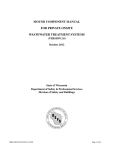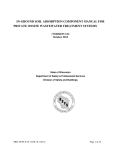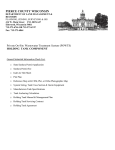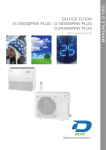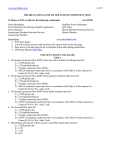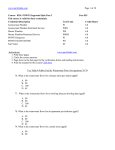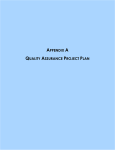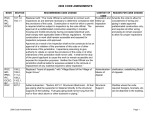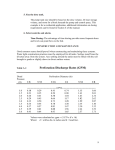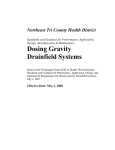Download At Grade Manual - garyklinka.com
Transcript
AT-GRADE USING PRESSURE DISTRIBUTION COMPONENT MANUAL FOR PRIVATE ONSITE WASTEWATER TREATMENT SYSTEMS (Version 2.0) State of Wisconsin Department of Commerce Division of Safety and Buildings SBD-10854-P (N. 03/07) TABLE OF CONTENTS Page I. Introduction and Specifications 3 II. Definitions 6 III. Description and Principle of Operation 7 IV. Soil and Site Requirements 8 V. Cover Material 9 VI. Design 10 VII. Site Preparation and Construction 14 VIII. Operation, Maintenance and Performance Monitoring 16 IX. References 18 X. At-grade Worksheet 19 XI. Example Worksheet 23 XII. Plan Submittal and Installation Inspection 27 Table 4 32 Published on March 01, 2007 by Dept. of Commerce Division of Safety and Buildings Safety and Buildings Publication SBD-10854-P (N. 03/07) ADA Statement The Department of Commerce is an equal opportunity service provider and employer. If you need assistance to access services or need material in an alternate format, please contact the Department at (608) 266-3151 or TTY (608) 264-8777. 2 of 33 I. INTRODUCTION AND SPECIFICATIONS: This Private Onsite Wastewater Treatment System (POWTS) component manual provides design, construction, inspection, operation, and maintenance specifications for an at-grade component. Violations of this manual constitute a violation of chs. Comm 83 and 84, Wis. Adm. Code. The atgrade component must receive influent flows and loads less than or equal to those specified in Table 1. When designed, installed and maintained in accordance with this manual, the at-grade component provides treatment and dispersal of domestic wastewater in conformance with ch. Comm 83 of the Wis. Adm. Code. Note: Detailed plans and specifications must be developed and submitted for review and approval to the governing unit having authority over the plan review. In addition, a state Sanitary Permit must be obtained from the department or governmental unit having jurisdiction. See Section XII for more details. Table 1 INFLUENT FLOWS AND LOADS Design Wastewater flow (DWF) ≤ 5000 gal/day Monthly average value of Fats, Oil and Grease (FOG) In accordance with s. Comm 83.44(2)(a), Wis. Adm. Code Monthly average value of five day Biochemical Oxygen Demand (BOD5) In accordance with s. Comm 83.44(2)(a), Wis. Adm. Code Monthly average value of Total Suspended Solids (TSS) In accordance with s. Comm 83.44(2)(a), Wis. Adm. Code Volume of a single dose ≥ 5 times the void volume of distribution lateral(s) and < 20% of the design wastewater flow Design wastewater flow (DWF) from one- and two-family dwellings In accordance with s. Comm 83.43(2), (3), (4) and (5), Wis. Adm. Code Design wastewater flow (DWF) from public facilities ≥ 150% of estimated wastewater flow in accordance with Table 4 of this manual or s. Comm 83.43(6), Wis. Adm. Code. Linear loading rate for components with in situ soils having a soil application rate of ≤ 0.3 gal/ft2/day within 12 inches of distribution cell ≤ 4.5 gal/ft Wastewater particle size ≤ 1/8 inch Distribution orifice spacing ≥ 1 orifice for every 2 linear feet of distribution cell 3 of 33 Table 2 SIZE AND ORIENTATION Total effective distribution cell area ≥ Design wastewater flow ÷ soil application rate for the most restrictive soil horizon that may affect treatment and dispersal. Soil application rates are listed in s. Comm 83 Table 83.44-1 or -2, Wis. Adm. Code. Effective distribution cell credit width (A) 10 ft or width of distribution cell, whichever is less Width of aggregate for level sites ≥ Effective distribution cell width Width of aggregate for sloping sites ≥ Effective distribution cell width + 2 ft Width of component area (W) ≥ Effective distribution cell width + 10 ft Effective distribution cell length (B) ≥ Design wastewater flow (DWF) ÷ Design soil application rate (DAR) ÷ Distribution cell width (A) Length of component area (L) ≥ Effective distribution cell length + 10 ft Depth of aggregate distribution cell at distribution pipe ≥ 8 inches + nominal diameter of distribution pipe Depth of aggregate distribution cell at edge ≥ 6 inches Depth of soil cover over distribution cell ≥ 12 inches Orientation Longest dimension parallel to surface grade contours on sloping sites. Deflection of distribution cell on concave slopes < 10% 4 of 33 Table 3 OTHER SPECIFICATIONS Slope of original grade ≤ 25% within the component area. Vertical depth of in situ soil between bottom of distribution cell and seasonal saturation defined by redoximorphic features, groundwater, or bedrock ≥ To depth required by s. Comm 83 Table 83.44-3, Wis. Adm. Code. Effluent application By use of a pressure distribution network conforming to Department of Commerce publications SBD-10573-P or SBD-10706-P, entitled “Pressure Distribution Component Manual for Private Onsite Wastewater Treatment Systems” and based on pipe sizing methods contained in Small Scale Waste Management Project publication 9.6 entitled “Design of Pressure Distribution Networks for Septic Tank – Soil Absorption Systems”. Piping Material in the distribution system Meets requirements of s. Comm 84.30(2), Wis. Adm. Code for its intended use. Piping material for observation and vent pipes Meets requirements of s. Comm 84.30, Table 84.30-1 Wis. Adm. Code. Distribution cell aggregate material Meets requirements of s. Comm 84.30(6)(i) & (k), Wis. Adm. Code. Fabric cover of distribution cell when aggregate is used Geotextile fabric meeting s. Comm 84.30(6)(g), Wis. Adm. Code. Location of distribution lateral(s) (for level sites) Equally spaced from the center of the distribution cell. Location of distribution lateral(s) (for sloping sites) Most up slope lateral at 2 feet from up slope edge of distribution cell. If more than one, no lateral may be installed in the lower half of distribution cell. Number of observation pipes per distribution cell ≥ Two extending from distribution cell infiltrative surface to finished grade. Location of observation pipes for level components Along opposite ends of distribution cell. Each at a distance equal of 1/5 to 1/10 of the distribution cell length measured from the end of the cell. Location of observation pipes for components on a slope Along the downslope toe at opposite ends of distribution cell. Each at a distance equal of 1/5 to 1/10 of the distribution cell length measured from the end of the cell. 5 of 33 Table 3 OTHER SPECIFICATIONS (continued) Cover material Fertile soil material (i.e. topsoil) containing less than 15% gravel by volume and no rock fragments greater than 3 inches diameter. The texture and structure of the soil cover provides adequate water holding capacity to sustain grasses to prevent erosion, promotes runoff from precipitation events, and allows atmospheric diffusion to the distribution cell below the soil cover. Soil finer than silt loam is not recommended. Limited activities during component construction Unless, otherwise specifically allowed in this manual, vehicular traffic, excavation, and soil compaction are prohibited in: The plowed area, and For sloping sites - 15 feet down slope of component area. For level sites – 10 feet on both sides of component area. Erosion and frost protection Graded to divert surface water around the component and sodded or seeded and mulched. Installation inspection In accordance with ch. Comm 83, Wis. Adm. Code. Management In accordance with ch. Comm 83, Wis. Adm. Code, and this manual. II. DEFINITIONS: Definitions not found in this section are located in ch. Comm 81 of the Wisconsin Administrative Code or the terms use the standard dictionary definition. A. ”At-grade” means an on-site wastewater treatment and distribution component. The component contains a distribution cell consisting of aggregate and a distribution network on top of the plowed in situ soil and is covered by soil. B. “Component Area” means the effective in situ soil surface area available for infiltration of effluent from the distribution cell, and the surrounding cover material. C. “Concave Site” means a slope shape where surface drainage may converge into a limited area. 6 of 33 D. “Distribution cell” means a layer of stone aggregate or synthetic aggregate that receives effluent from a distribution network and distributes that effluent onto a plowed in situ soil dispersal area. E. “Slowly Permeable Soil” means soil with textural classifications of clay loams and silty clay loams that exhibit a moderate grade of structure; and loams, silt loams, and silts with weak grades of structure; or soils with weak to moderate grades of platy structure according to the US Department of Agriculture, Natural Resource Conservation Service classification system. F. “Unsaturated flow” means liquid flow through a soil media under a negative pressure potential. Liquids containing pathogens and pollutants come in direct contact with soil or fill material microsites that enhance wastewater treatment by physical, biological, and chemical means. G. “Vertical Flow” means the downward flow of water or effluent through soil that involves travel along soil surfaces or through soil pores. III. DESCRIPTION AND PRINCIPLE OF OPERATION: The operation of the at-grade component is a two-stage process involving both wastewater treatment and dispersal into the underlying soil. Treatment is accomplished predominately by physical and biochemical processes within the soil. These processes are affected by the physical characteristics of the effluent wastewater, influent application rate, temperature, and the nature of the receiving soil. Physical entrapment, increased retention time, and conversion of pollutants in the wastewater are important treatment objectives accomplished under unsaturated conditions. Pathogens contained in the wastewater are eventually deactivated through filtering, retention, and adsorption by the soil. In addition, many pollutants are converted to other chemical forms by oxidation processes. The at-grade component contains a distribution cell consisting of stone aggregate and a distribution network on top of the plowed in situ soil dispersal area and is covered by soil. Effluent is distributed into the distribution cell where it flows into the soil where it undergoes biological, chemical, and physical treatment and dispersal into the environment. See Figures 1, 2 and 3 for examples of a typical at-grade component. Cover material, consisting of soil provides frost protection and moisture retention sufficient to maintain a good vegetative cover. The in situ soil serves as the treatment medium and disperses the effluent into the environment. Figure 1 - A cross-section of a POWTS at-grade component 7 of 33 This manual specifies site characteristics, design criteria and construction techniques for an at-grade component to provide treatment and dispersal of domestic wastewater meeting the standards of s. Comm 83.44 (2) Wis. Adm. Code. In an at-grade component design using pressure distribution, the effluent enters the more permeable topsoil over a large area, where it can move laterally until absorbed by the less permeable subsoil. IV. SOIL AND SITE REQUIREMENTS: Every at-grade design is ultimately matched to the given soil and site characteristics. The design approach is based on criteria that all applied wastewater is successfully transported away from the component, in a manner that will not influence later wastewater additions, and that the effluent is ultimately treated. 8 of 33 A. Minimum Soil Depth Requirements: The minimum soil factors required for successful at-grade component performance are listed in Tables 1, 2 and 3. Soil evaluations must be in accordance with ch. Comm 85, Wis. Adm. Code. In addition, soil application rates must be in accordance with ch. Comm 83, Wis. Adm. Code. B. Other Site Considerations 1. Slopes: On a crested site the distribution cell can be situated such that the effluent can move laterally down both slopes. A level site allows lateral flow in all directions, but may present problems as the water table may rise higher beneath the distribution cell in slowly permeable soils. Sloping sites allow the liquid only to move in one direction away from the distribution cell. On sloping sites and sites with slowly permeable soils, at-grade components rely on lateral effluent movement through the upper soil horizons. Lateral movement becomes more important as soil permeability decreases. Concave sloping sites are sites that have convergence of surface and subsurface drainage. Landscape topography that retains or concentrates subsurface flows; such as swales, depressions or potholes, is considered an unacceptable at-grade location. The maximum deflection allowed, as listed in Table 2 is 10%. Over land surface flow is to be diverted from the site or other methods employed to allow surface flow around the component. 2. At-grade location: Open areas and exposure to sun and wind increase the assistance of evaporation and transpiration in the dispersal of wastewater. 3. Sites with trees and large boulders: Generally, sites with large trees, numerous smaller trees or large boulders are less desirable for installing an at-grade component. These sites create difficulty in preparing the surface and reduce the infiltration area beneath the at-grade. Rock fragments, tree roots stumps and boulders occupy an area, thus reducing the amount of soil available for proper treatment. If no other site is available, trees in the component area of the at-grade must be cut off at ground level and boulders that are setting on the ground surface removed. A larger infiltrative area is necessary when any of the above conditions are encountered, to provide sufficient effective distribution cell area. 4. Setback distances: The setbacks specified in ch. Comm 83, Wis. Adm. Code for soil subsurface treatment and distribution components apply to at-grade components. The distances are measured from the perimeter of the effective distribution cell area. V. COVER MATERIAL: The cover material (above the distribution cell and absorption area) means fertile soil material (i.e. topsoil) containing less than 15% gravel by volume and no rock fragments greater than 3 inches diameter. The texture and structure of the soil cover provides adequate water holding capacity to sustain grasses to prevent erosion, promotes runoff from precipitation events, and allows atmospheric diffusion to the distribution cell below the soil cover. Soil finer than silt loam is not recommended. 9 of 33 VI. DESIGN: A. Location, Size and Shape: Placement, sizing and shaping of the at-grade must be in accordance with this manual. The means of pressurizing the distribution network must provide equal distribution of effluent along the length of the distribution cell. A pressure distribution network conforming to Department of Commerce publications SBD-10573-P or SBD-10706-P, entitled “Pressure Distribution Component Manual for Private Onsite Wastewater Treatment Systems” and based on pipe sizing methods contained in Small Scale Waste Management Project publication 9.6 entitled “Design of Pressure Distribution Networks for Septic Tank – Soil Absorption Systems” must be used. B. Component Design: Detailed plans and specifications must be developed and then reviewed and approved by the governing unit having authority over plan review. Design of the at-grade component is based on the design wastewater flow and soil characteristics. It must be sized such that it can accept the daily flows and loads without causing surface seepage or groundwater pollution. Consequently, the effective distribution cell area must be sufficiently large enough to absorb the effluent into the underlying soil. Design of the at-grade includes the following three steps, (1) calculating the design wastewater flow, (2) design of the distribution cell and (3) design of the entire at-grade component. Each step is discussed. A design example is included at the end of this manual. 1. Design Wastewater Flow Calculations a) One and two-family dwellings: Effective distribution cell size for one- and twofamily dwelling application is determined by first calculating the design wastewater flow (DWF). To calculate DWF use Formula 1. Formula 1 DWF = 150 gallons/day/bedroom b) Public Facilities: Effective distribution cell size for public facilities application is determined by calculating the DWF using Formula 2. Public facility estimated daily wastewater flows are listed in Table 4, at the end of this manual. Facilities that are not listed in Table 4 are not included in this manual. Many commercial facilities have high BOD5, TSS and FOG (fats, oils and grease), which must be pretreated in order to bring their values down to an acceptable range before entering into the at-grade component described in this manual. Formula 2 DWF = Sum of each estimated wastewater flow per source per day (from Table 4) x 1.5 10 of 33 2. Design of the Distribution cell; This section determines the required effective cell area of the distribution cell as well as the dimensions for the soil cover material. a) Determine the design-loading rate (DLR) for the site. The design-loading rate equals the soil application rate of the soil horizon in contact with the distribution cell. Use Table 83.44-1 or -2, Wis. Adm. Code, to determine the soil application rate. Note that s. Comm 83.44(4)(c), Wis. Adm. Code, requires designers to consider more restrictive subsoil horizons. b) Determine the effective area of the distribution cell. The effective area of the distribution cell is calculated by dividing design wastewater flow (DWF) by the design-loading rate (DLR). c) Choose an effective distribution cell credit width The effective credit width can not exceed 10 ft. Determine the distribution cell length (B). The distribution cell length (B) is calculated by dividing the effective area of the distribution cell by the effective width (A) of the distribution cell. d) Determine the linear loading rate (LLR). The linear loading rate is calculated dividing the design wastewater flow (DWF) by the distribution cell length (B). For systems that have in situ soil having a soil application rate ≤ 0.3 gal/ft2/day that are within 12 inches below the distribution cell, the linear loading rate (LLR) can not exceed 4.5 gal/ft/day. If the LLR exceeds 4.5 gal/ft/day for such soils, the component must be lengthened to reduce the LLR to 4.5 gal/ft/day or less. e) Concave at-grade configuration The maximum deflection of a concave distribution cell of an at-grade.system is 10%. The percent of deflection of a distribution cell is determined by dividing the amount of deflection by the effective distribution cell length of the concave distribution cell. The deflection is the maximum distance between the down slope edge of a concave distribution cell to the length of a perpendicular line that intersects furthest points of the contour line along the down slope edge of the distribution cell. The effective distribution cell length of the concave distribution cell is the distance between the furthest points along the contour line of the down slope edge of the concave distribution cell. See Figure 4. The deflection of a distribution cell on concave slopes is calculated using Formula 3. Formula 3 f) Percent of Deflection = (Deflection ÷ Effective distribution cell length) x 100 Where: Deflection = Maximum distance between the down slope edge of a concave distribution cell to the length of a perpendicular line that intersects furthest points of the contour line along the down slope edge of the distribution cell 11 of 33 Effective distribution cell length = Distance between the furthest points along the contour line of the down slope edge of the concave distribution cell 100 = Conversion factor The actual distribution cell length must be checked to determine if the cell area is sufficient. The actual distribution cell length is calculated using Formula 4. Formula 4 Actual distribution cell length = [(% of deflection x 0.00265) + 1] x effective distribution cell length Where: % of deflection = Determined by Formula 3 0.00265 = Conversion factor from percent to feet 1 = Constant Figure 4 – Concave at-grade and Distribution Cell 3. Design of the entire at-grade component: This includes sizing the total width and length of the distribution cell, component height, location of the effluent distribution lateral, and observation pipes. a) Determine the total width of distribution cell for level sites, the total width of distribution cell (TW) is equal to or greater than the effective distribution cell credit width (A). TW ≥ A b) For sloping sites, the total width of distribution cell is equal to or greater than the effective distribution cell credit width (A) plus 2 feet. TW ≥ A + 2 feet 12 of 33 c) Determine the overall width (W) of the component: The minimum width of component must be equal to or greater than the total width of distribution cell plus 10 ft for soil cover. W ≥ TW + 10 ft NOTE: Greater widths for landscaping purposes are satisfactory. d) Determine the overall length (L) of the component: Minimum overall length of component must be equal to or greater than the distribution cell length (B) plus 10 ft for soil cover. L ≥ B + 10 ft NOTE: Greater lengths for landscaping purposes are satisfactory. e) Horizontal location of distribution lateral in the distribution cell: (1) Level site with one effluent distribution lateral; the lateral is located in the center of distribution cell. (2) Level site with more than one effluent distribution lateral; the laterals are equally spaced apart with the center two laterals the same distance from center of the cell and the distance from the outside laterals to the edge of the cell being one half the lateral spacing. (3) Sloping site with one lateral; the effluent distribution lateral is located 2 feet down slope from up slope edge of the distribution cell. (4) Sloping site with more than one effluent distribution lateral; one lateral is located 2 feet down slope from the up slope edge of the distribution cell and the other(s) is (are) down slope of the upper lateral and up slope of the mid point of the distribution cell effective width. f) Vertical location of distribution lateral in the distribution cell: The distribution lateral must be at least 6 inches above the elevation of original grade before plowing. 13 of 33 g) Determine the height of the component: (1) Height of component over the distribution lateral must be equal to or greater than 6 inches of aggregate beneath distribution pipe plus the nominal diameter of distribution lateral plus 2 inches above the distribution lateral plus 12 inches of soil cover. (2) Height of component over the rest of the distribution cell must be equal to or greater than 6 inches of aggregate plus 12 inches of soil cover. h) Location of the observation pipes: (1) Components on a level site must include two observation pipes. The observation pipes are along opposite ends of the distribution cell and located at a distance equal to 1/5 to 1/10 of the distribution cell length measured from the end of the cell. (2) Components on a sloping site must include two observation pipes. The observation pipes are along the down slope toe at opposite ends of the distribution cell and located at a distance equal to 1/5 to 1/10 of the distribution cell length measured from the end of the cell. i) Distribution Network and Dosing System: A pressure distribution network conforming to Department of Commerce publications SBD-10573-P or SBD-10706-P, entitled “Pressure Distribution Component Manual for Private Onsite Wastewater Treatment Systems” and based on pipe sizing methods contained in Small Scale Waste Management Project publication 9.6 entitled “Design of Pressure Distribution Networks for Septic Tank – Soil Absorption Systems” must be used. VII. SITE PREPARATION AND CONSTRUCTION: Procedures used in the construction of an at-grade component are just as critical as the design of the component. A good design with poor construction results in component failure. It is emphasized that the soil only be plowed when it is not frozen and the moisture content is low to avoid compaction and puddling. Consequently, installations are to be made only when the soil is dry as required. The construction plan to be followed includes: A. Equipment: Proper equipment is essential. Track type tractors or other equipment that will not compact the atgrade area or the down slope area are required. B. Sanitary Permit: Prior to the construction of the component, a state Sanitary Permit shall be obtained and posted in a clearly visible location on the site. Arrangements for inspection(s) must also be made with the governmental unit issuing the Sanitary Permit. [NOTE: When a POWTS is located or will be located on property owned by the state, the Sanitary Permit shall be obtained from the department. Arrangements for inspections(s) shall be made with the department.] C. Construction Procedures: 1. Check the moisture content of the soil to a depth of 8 inches or to the anticipated plow depth, whichever is greater. Smearing and compacting wet soil will result in reducing the infiltration capacity of the soil. Proper soil moisture content can be determined by rolling a 14 of 33 soil sample between the hands. If it rolls into a 1/4-inch wire, the site is too wet to prepare. If it crumbles, site preparation can proceed. If the site is too wet to prepare, do not proceed until it dries. 2. Lay out the distribution cell area on the site so that the upslope edge of the effective distribution cell is level or on a contour line (points of equal elevation). 3. For components in open areas, measure the average ground elevation along the up slope edge of the distribution cell. For components on uneven sites (rough terrain), plow the surface, before the average ground elevation along the up slope edge of the distribution cell is measured. The average elevation is referenced to a benchmark for future use. This is necessary to determine the bottom elevation of the distribution cell. Note that the entire component area (L x W) is plowed. 4. Determine where the force main from the dosing chamber will connect to the distribution system in the distribution cell. Place the pipe either before or after plowing. If the force main is to be installed in the down slope area, the trench for the force main may not be wider than 12 inches. 5. Cut trees as close as possible to the ground surface and leave stumps, remove surface boulders that can be easily rolled off, remove vegetation over 6 inches long by mowing and removing cut vegetation. Prepare the site by plowing the surface soil perpendicular to the direction of the slope, and to a depth of 7-8 inches so as to eliminate any surface mat that could impede the vertical flow of liquid into the in situ soil. Plowing with a Moldboard plow is done along contours. Chisel plowing is the preferred method especially in fine textured soils. Rototilling or other means that pulverize the soil is not acceptable. The important point is that an uncompacted rough, unsmeared surface be left. The aggregate will intermingle between the clods of soil, which maintains the infiltration rate into the natural soil. 6. The required observation pipes must have slots on the bottom 6 inches of the observation pipe. Installations of all observation pipes include a suitable means of anchoring. See Figure 5. Figure 5 Observation pipes 7. Immediate application of at least 6 inches of aggregate is required after plowing. Shape the aggregate to obtain a uniform minimum depth of at least 6 inches above the original 15 of 33 grade. All vehicular traffic is prohibited on the plowed area. On sloping sites, vehicle traffic is also prohibited for 15 ft. down slope and 10 ft. on both sides of level sites. If it rains after the plowing is completed, wait until the soil dries out before continuing construction, and contact the local inspector for a determination on the damage done by rainfall. 8. Place the effluent distribution lateral(s) on the aggregate. Connect the lateral(s) using the needed connections and piping to the force main pipe from the dosing chamber. Slope the piping from the lateral(s) to the force main pipe or lay the effluent distribution lateral(s) level, with the perforations down. All pipes shall drain after dosing. 9. Place at least 2 inches of aggregate over the lateral(s). 10. Place geotextile fabric conforming to requirements of ch. Comm 84, Wis. Adm. Code, over the aggregate. 11. Place soil cover material on top of the geotextile fabric and extend the soil cover to the boundaries of the overall component. 12. Complete final grading to divert surface water drainage away from the at-grade. Sod or seed and mulch the entire at grade component. VIII. OPERATION, MAINTENANCE AND PERFORMANCE MONITORING: A. Owner is Responsible: The POWTS owner is responsible for the operation and maintenance of the component. The county, department or POWTS service provider may make periodic inspections of the components, checking for surface discharge, and ponded effluent levels in the observation pipes, etc. The owner or owner's agent is required to submit necessary maintenance reports to the governmental unit or designated agent. B. Approvals and Inspections: Design approvals and site inspection before, during, and after the construction is accomplished by the governmental unit or other appropriate jurisdiction(s) in accordance with ss. Comm 83.22 and 83.26, Wis. Adm. Code. 16 of 33 C. Routine and preventative maintenance aspects: 1. Treatment and dose tanks along with related mechanical components are to be inspected routinely and maintained when necessary in accordance with the management plan. 2. Inspections of the at-grade component are required at least once every three years. These inspections include checking the liquid levels in the observation pipes and examination for any seepage around the component. 3. Traffic, except for lawn maintenance, on the at-grade component is not permitted to avoid frost penetration in winter and to minimize compaction during other times. 4. A good water conservation plan within the house or establishment will help assure that the at-grade component will not be overloaded. D. User’s Manual: A user’s manual is to accompany the at-grade component and be provided to the owner following installation. At a minimum, the manual is to contain the following information: 1. Diagram(s) of all components and their location. This should include the location of the reserve area, if one is provided. 2. Names and phone numbers of local governmental unit authority, component manufacturer or POWTS service provider to be contacted in the event of component failure or malfunction. 3. A management plan that contains information on the periodic inspection, maintenance or servicing of the component, including electrical/mechanical components. 4. What activities can or cannot occur on the reserve area, if one is provided. 5. Notice that the dose chamber, if one is utilized, may fill due to flow continuing during pump malfunction or power outages. One large dose when the power comes on or when the pump is repaired may cause the distribution component to over load. In this situation, the pump chamber should be pumped by a certified septage servicing operator before pump cycling begins or other measures shall be used to dose the at grade component with only the proper amount of influent. This may include manual operation of the pump controls until such time the pump chamber has reached its normal level. E. Performance: Performance monitoring must be completed on at-grade components installed in accordance with this manual. 17 of 33 1. The frequency of monitoring must be: a) At least once every three years after installation, and b) At time of problem, complaint, or failure. 2. The minimum criteria addressed in performance monitoring of at-grade components are: a) Type of use. b) Age of component. c) Nuisance factors, such as odors or user complaints. d) Mechanical malfunction within the component including problems with valves or other mechanical or plumbing components. e) Material fatigue or failure, including durability or corrosion as related to construction or structural design. f) Neglect or improper use, such as overloading the design rate, poor maintenance of vegetative cover, inappropriate cover over the at-grade, or inappropriate activity over the at-grade component. g) Installation problems such as compaction or displacement of soil, improper orientation or location. h) Pretreatment component maintenance, including dosing frequency, structural integrity, groundwater intrusion or improper sizing. i) Pump or siphon chamber maintenance, including improper maintenance, infiltration, structural problems, or improper sizing. j) Ponding in distribution cell, prior to the pump cycle. Ponding may be evidence of development of a clogging mat or reduced infiltration rates. k) Siphon or pump malfunction including dosing volume problems, pressurization problems, breakdown, burnout, or cycling problems. l) Overflow or seepage problems, as shown by evident or confirmed sewage effluent, including backup if due to clogging. 3. Reports are to be submitted to the governmental unit or designated agent in accordance with ch. Comm 83, Wis. Adm. Code. IX. REFERENCES: J.C. Converse, E. Jerry Tyler, and James O. Peterson 1990. “Wisconsin At-Grade Soil Absorption System Siting, Design, and Construction Manual” Small Scale Waste Management Project #15.21. 18 of 33 X. AT-GRADE WORKSHEET: AT-GRADE WORKSHEET A. SITE CONDITIONS: Evaluate the site and soils report for the following: a) Surface water movement. b) Measure elevations and distances on the site so that slope, contours and available areas can be determined. c) Description of several soil profiles where the component will be located. d) Determine the limiting conditions such as bedrock, high groundwater level, soil permeability, and setbacks. Slope - % Occupancy: One- or Two-family Dwelling, # of bedrooms Public Facility Depth to limiting factor - inches gal/ft2/day In situ soil application rate used - B. DESIGN WASTEWATER FLOW (DWF): 1. One- or Two-family Dwelling: DWF = 150 gal/day/bedroom x # of bedrooms # of bedrooms = 150 gal/day/bedroom x = gal/day 2. Public Facilities: DWF = Sum of each wastewater flow per source per day x 1.5 = gal/day x 1.5 = gal/day 19 of 33 C. Effective width and length of the distribution cell: 1. Determine the design loading rate (DLR) for the site: From Table 83.44-1 or -2, Wis. Adm. Code, select the soil application rate for the most restrictive soil horizon that may affect treatment and dispersal. The soil application rate selected from Table 83.44-1 or -2, Wis. Adm. Code, is the design-loading rate (DLR) for the site. DLR = _____ gal/ft2/day 2. Determine the distribution cell area. Calculate the distribution cell area by dividing the daily design wastewater flow (DWF) by the design-loading rate (DLR). Distribution cell area = DWF ÷ DLR Distribution cell area = _____ gpd ÷ ____ gal/ft2/day Distribution cell area = _____ ft2 3. Select an effective distribution cell width (A). The effective width can not exceed 10 feet. A = ____ ft 4. Determine the distribution cell length. Calculate the distribution cell length (B) by dividing the required distribution area by the effective distribution cell width (A). B = Distribution cell area ÷ A B = _____ ft2 ÷ ____ ft B = _____ ft 5. Check percent of deflection and actual length of concave distribution cell length Percent of deflection = Deflection ÷ Effective distribution cell length x 100 Percent of deflection = ft ÷ Percent of deflection = % (≤ 10%) ft x 100 Actual distribution cell length = [(% of deflection x 0.00265) + 1] x effective distribution cell length Actual distribution cell length = [( Actual distribution cell length = % x 0.00265) +1] x ft 20 of 33 ft 6. Determine the linear loading rate (LLR) if, the soil application rate of any horizon within 12 inches below the distribution cell has a soil application rate of ≤ 0.3 gal/ft2/day. If the LLR exceeds 4.5 gal/ft/day for such soils, the component must be lengthened to reduce the LLR to 4.5 gal/ft/day or less. LLR = DWF ÷ B gal/day ÷ LLR = LLR = ft gal/day/ft D. Design of entire at-grade component: 1. Determine the total width of distribution cell. For level site, the total width of the distribution cell (TW) is equal to or greater than the effective distribution cell credit width (A). TW ≥ A TW = ______ ft For sloping site, the total width of the distribution cell (TW) is equal to or greater than the effective distribution cell credit width (A) + 2 feet. TW ≥ A + 2 feet TW ≥ _____ ft + 2 feet TW = _____ ft 2. Determine the overall width (W) of the component. W ≥ TW + 10 ft W≥ ft + 10 ft. W= ft 3. Determine the overall length (L) of the component. L ≥ B + 10 ft L≥ ft + 10 ft. L= ft 21 of 33 4. Horizontal location of distribution lateral in the distribution cell. Level site with one effluent distribution lateral; the lateral is located in the center of distribution cell. Level site with more than one effluent distribution lateral; the laterals are equally spaced apart with the center two laterals the same distance from center of the cell and the distance from the outside laterals to the edge of the cell being one half the distance between laterals. Sloping site with one effluent distribution lateral; the effluent distribution lateral is located 2 feet in from up slope edge of total distribution cell. Sloping site with more than one effluent distribution lateral; one lateral is located 2 feet down slope from the up slope edge of the distribution cell and the others are down slope of the upper lateral and up slope of the mid point of the distribution cell credit width. 5. Vertical location of distribution lateral in the distribution cell. Elevation of distribution lateral invert ≥ elevation of original contour directly under distribution lateral + 6 inches Elevation of distribution lateral invert ≥ ft. + 0.5 ft. Elevation of distribution lateral invert = ft. 6. Determine the location of observation pipes along the length of distribution cell. Distance from end of distribution cell to end observation pipes = B ÷ 5 to 10 Distance from end of distribution cell to end observation pipes = ft. ÷ 5 to 10 Distance from end of distribution cell to end observation pipes = ft. 22 of 33 XI. EXAMPLE WORKSHEET: AT-GRADE WORKSHEET A. SITE CONDITIONS: Evaluate the site and soils report for the following: 1. Surface water movement. 2. Measure elevations and distances on the site so that slope, contours and available areas can be determined. 3. Description of several soil profiles where the component will be located. 4. Determine the limiting conditions such as bedrock, high groundwater level, soil permeability, and setbacks. Slope - <1 % Occupancy: One- or Two-family Dwelling, # of bedrooms - 3 Public Facility Depth to limiting factor - 38 inches In situ soil application used - 0.6 gal/ft2/day B. DESIGN WASTEWATER FLOW (DWF): 1. One- or Two-family Dwelling. DWF = 150 gal/day/bedroom x # of bedrooms = 150 gal/day/bedroom x 3 # of bedrooms = 450 gal/day 2. Public Facilities: DWF = Sum of each wastewater flow per source per day x 1.5 = gal/day x 1.5 = gal/day 23 of 33 C. Effective width and length of the distribution cell: 1. Determine the design-loading rate (DLR) for the site. From Table 83.44-1 or 2, Wis. Adm. Code, select the soil application rate for the most restrictive soil horizon that may affect treatment and dispersal. The soil application rate selected from Table 83.44-1 or -2, Wis. Adm. Code, is the design-loading rate (DLR) for the site. DLR = 0.6 gal/ft2/day 2. Determine the distribution cell area. Calculate the distribution cell area by dividing the daily design wastewater flow (DWF) by the design-loading rate (DLR). Distribution cell area = DWF ÷ DLR Distribution cell area = 450 gpd ÷ 0.6 gal/ft2/day Distribution cell area = 750 ft2 3. Select an effective distribution cell width (A). The effective width can not exceed 10 feet. A= 10 ft 4. Determine the distribution cell length. Calculate the distribution cell length (B) by dividing the required distribution area by the effective distribution cell width (A). B = Distribution cell area ÷ A B = 750 ft2 ÷ 10 ft B = 75 ft 5. Check percent of deflection and actual length of concave distribution cell length Percent of deflection = Deflection ÷ Effective distribution cell length x 100 Percent of deflection = ft ÷ Percent of deflection = % (≤ 10%) ft x 100 Actual distribution cell length = [(% of deflection x 0.00265) + 1] x effective distribution cell length Actual distribution cell length = [( Actual distribution cell length = % x 0.00265) +1] x ft 24 of 33 ft 6. Determine the linear loading rate (LLR) if, the soil application rate of any horizon within 12 inches below the distribution cell has a soil application rate of ≤ 0.3 gal/ft2/day. If the LLR exceeds 4.5 gal/ft/day for such soils, the component must be lengthened to reduce the LLR to 4.5 gal/ft/day or less. LLR = DWF ÷ B gal/day ÷ LLR = LLR = ft gal/day/ft D. Design of entire at-grade component: 1. Determine the total width of distribution cell. For level site, the total width of the distribution cell (TW) is equal to or greater than the effective distribution cell credit width (A). TW ≥ A TW = 10 ft For sloping site, the total width of the distribution cell (TW) is equal to or greater than the effective distribution cell credit width (A) + 2 feet. TW ≥ A + 2 feet TW ≥ _____ ft + 2 feet TW = _____ ft 2. Determine the overall width (W) of the component. W≥ 10 ft + 10 ft. W= 20 ft W ≥ TW + 10 ft 3. Determine the overall length (L) of the component. L ≥ B + 10 ft L≥ 75 ft + 10 ft. L= 85 ft 4. Horizontal location of distribution lateral in the distribution cell. X Level site with one effluent distribution lateral; the lateral is located in the center of distribution cell. Level site with more than one effluent distribution lateral; the laterals are equally spaced apart with the center two laterals the same distance from center of the cell and 25 of 33 the distance from the outside laterals to the edge of the cell being one half the distance between laterals. Sloping site with one effluent distribution lateral; the effluent distribution lateral is located 2 feet in from up slope edge of total distribution cell. Sloping site with two effluent distribution laterals; one lateral is located 2 feet down slope from the up slope edge of the distribution cell and the others are down slope of the upper lateral and up slope of the mid point of the distribution cell credit width. 5. Vertical location of distribution lateral in the distribution cell. Elevation of distribution lateral invert ≥ elevation of original contour directly under distribution lateral + 6 inches Elevation of distribution lateral invert ≥ 105 ft. + 0.5 ft. Elevation of distribution lateral invert = 105.5 ft. 6. Determine the location of observation pipes along the length of distribution cell. Distance from end of distribution cell to end observation pipes = B ÷ 5 to 10 Distance from end of distribution cell to end observation pipes = 75 ft. ÷ 5 to 10 Distance from end of distribution cell to end observation pipes = 12.5 ft. 26 of 33 XII. PLAN SUBMITTAL AND INSTALLATION INSPECTION: A. Plan Submittal: In order to install a POWTS correctly, it is important to develop plans that will be used to guide the installation. The following checklist may be used when preparing plans for review. Conformance to the list is not a guarantee of plan approval. Additional information may be needed or requested to address unusual or unique characteristics of a particular project. Contact the reviewing agency for specific plan submittal requirements, which may be different than the list included in this manual. B. General Submittal Information: 1. Legible photocopies of reports forms, plans, and other documents are acceptable. However, an original signature is required on certain documents (e.g. index page). 2. Submittal of additional information requested during plan review, or questions concerning a specific plan shall be referenced to the Identification number assigned to that plan by the reviewing agency. 3. Plans or documents must be permanent, legible copies or originals. C. Forms and Fees: A current version of a completed Application For Review form, (SBD-10577) along with proper fees must be included with plans submitted to the department. An Application can be downloaded at www.commerce.wi.gov. If plans are to be submitted to a designated county plan review agent, the agent should be contacted for information regarding application forms and fees. D. Soils Information: 1. A completed Soils Evaluation Report form, (SBD-8330) signed and dated by a certified soil tester, with credential number. 2. Separate sheet showing the location of all borings. The location of all borings and observation pits must be able to be identified on the plot plan. E. Documentation: 1. Architects, engineers or designers shall sign, seal and date each page of the submittal or sign, seal and date index page, which is attached to the bound set. 2. Master Plumbers and Master Plumbers Restricted Service shall sign, date and include their license number on each page of the submittal or sign and date an index page, which is attached to each bound set. 3. At least three sets of plans and specifications (clear, permanent and legible) shall be submitted to the department. Submittals must be on paper measuring at least 8-1/2 by 11 inches. Each plan set shall be bound by staples, brads or other fasteners. Pages which 27 of 33 are held together by rubber bands and/or paper clips are not considered to be a bound volume. F. Plot Plan Information: 1. Dimensioned plans or plans drawn to scale (scale indicated on plans) with property lines, parcel size and property boundaries clearly marked. 2. Slope directions and percent in component area. 3. Benchmark and north arrow. 4. Pertinent setbacks distances as per appropriate code. 5. Two-foot contours or other appropriate contour interval within the system area. 6. Location information; legal description down to 40 acres and /or subdivision, block and lot number of platted lands. 7. Pertinent existing and proposed buldings, wells water lines, swimming pools, flood plain location and elevation and OHWM designations of navigable waters. G. Plan View: 1. Dimensions for distribution cell(s). 2. Location of observation pipes. 3. Pipe lateral layout, which includes the number of laterals, pipe material, diameter and length; and number, location and size of orifices. 4. Manifold/force main locations, with materials, length and diameter of each. H. Cross Section of Component: 1. Include plowing requirement, distribution cell details, and cover material. 2. Lateral elevation, position of observation pipes, dimensions of distribution cell, and geotextile fabric barrier. I. Component Sizing: 1. For one- and two-family dwellings, the number of bedrooms shall be included. 2. For public buildings, the sizing calculations shall be included. 28 of 33 J. Tank and Pump / Siphon Information: 1. Construction details for site-constructed tanks. (Note: site constructed tanks that do not have a valid plumbing product approval are not included within the scope of this manual and must be submitted as individual site designs.) 2. Size, model number and manufacturer information for prefabricated tank(s). 3. Installation information must include vent and access opening locations, depth to inlet; and height/elevation of freeboard, if applicable. 4. Anchoring information shall be provided whenever a tank is located within the 100-year floodplain and/or the depth to seasonal soil saturation indicates anchoring is necessary to prevent flotation of the tank. 5. Notation of pump or siphon model, pump performance curve, friction loss for force main and calculation for total dynamic head. 6. Notation of high water alarm manufacturer and model number. 7. Cross section of tank / chamber to include storage volumes; connections for piping, vents, and power; pump “off” setting; dosing cycle and volume; high-water alarm setting and storage volume above the high-water alarm. 8. Cross section of two compartments tanks or tanks installed in series shall include information listed above. K. Inspections: Inspection shall be made in accordance with ch. 145.20, Wis. Stats., and s. Comm 83.26, Wis. Adm. Code. The inspection form on the following two pages may be used. The inspection of the component installation and/or plans is to verify that the component conforms to specifications listed in Tables 1-3 of this manual and the approved plans. 29 of 33 POWTS INSPECTION REPORT (ATTACH TO PERMIT) GENERAL INFORMATION Permit Holder’s Name City Plan ID No. Village Town of County Tax Parcel No. Sanitary Permit No. Property Address if Available TANK INFORMATION TYPE SETBACKS MANUFACTURER Model # CAPACITY P/L WELL BLDG. VENT TO AIR INTAKE ROAD SEPTIC DOSING AERATION PUMP / SIPHON INFORMATION Manufacturer: Model No. Demand in GPM FORCE MAIN INFORMATION Length Diameter Vert. Lift FRICTION LOSS Dist. To Well Component Head TDH - As Built TDH - Design SOIL ABSORPTION COMPONENT TYPE OF COMPONENT Cell Width Cell Length SETBACK INFO. COVER MATERIAL Cell Depth Horizontal Separation Property Line Bldg. No. of Cells Well Lake/Stream DISTRIBUTION COMPONENT / Elevation data on back of form Header / Manifold Distribution Pipe(s) Length Length Dia. Dia. Hole size Hole Spacing Obsv. Tubes Inst. & No. Spacing SOIL COVER Depth over laterals: Depth over edge of cell: Depth of cover material Seeded / Sodded Mulched DEVIATIONS FROM APPROVED PLAN COMMENTS (Persons present, discrepancies, etc.) COMPONENTS NOT INSPECTED Plan Revision Required Yes No Date: Signature of Inspector: 30 of 33 Cert. Number ELEVATION DATA Point Backsight Height of Instrument Foresight Elevation Comments Bench mark Bldg. sewer Tank inlet Tank outlet Tank inlet Tank outlet Dose tank inlet Bottom of dose tank Dist. lateral 1 Component elev. 1 Dist. lateral 2 Component elev. 2 Dist. lateral 3 Component elev. 3 Grade elev. 1 Grade elev. 2 Grade elev. 3 SKETCH OF COMPONENT & ADDITIONAL COMMENTS 31 of 33 Table 4 Public Facility Wastewater Flows Source Unit Estimated Wastewater Flow (gpd) Apartment or Condominium Assembly hall (no kitchen) Bar or cocktail lounge (no meals served) Bar or cocktail lounge* (w/meals - all paper service) Beauty salon Bowling alley Bowling alley (with bar) Camp, day and night Camp, day use only (no meals served) Campground or Camping Resort Bedroom Person (10 sq. ft./person) Patron (10 sq. ft./patron) Patron (10 sq. ft./patron) Station Bowling lane Bowling lane Person Person Space, with sewer connection and/or service building Camping unit or RV served Basin Person Person Person (10 sq. ft./person) Child Child Meal served 100 1.3 4 8 90 80 150 25 10 30 Meal served 5 Meal served 7 Patron seating space Vehicle space 10 10 Vehicle space Employee Drain Patron (minimum 500 patrons) 3 13 25 3 Patron Service bay Bed space Room 3 50 135 65 Person Person Person Employee 50 13 6.5 20 Campground sanitary dump station Catch basin Church (no kitchen) Church* (with kitchen) Dance hall Day care facility (no meals prepared) Day care facility* (with meal preparation) Dining hall* (kitchen waste only without dishwasher and/or food waste grinder) Dining hall* (toilet and kitchen waste without dishwasher and/or food waste grinder) Dining hall* (toilet and kitchen waste with dishwasher and/or food waste grinder) Drive-in restaurant* (all paper service with inside seating) Drive-in restaurant* (all paper service without inside seating) Drive-in theater Employees (total all shifts) Floor drain (not discharging to catch basin) Gas station / convenience store Gas station (with service bay) Patron Service bay Hospital* Hotel, motel or tourist rooming house Medical office building Doctors, nurses, medical staff Office personnel Patients Migrant labor camp (central bathhouse) * May be high strength waste 32 of 33 25 65 2 5 2 12 16 2 Table 4 Public Facility Wastewater Flows (continued) Source Unit Estimated Wastewat er Flow (gpd) Mobile Home (Manufactured home) (served by its own POWTS) Mobile home park Nursing, Rest Home, Community Based Residential Facility Outdoor sport facilities (toilet waste only) Parks (toilets waste only) Parks (toilets and showers) Public shower facility Restaurant*, 24-hr. (dishwasher and/or food waste grinder only) Restaurant*, 24-hr. (kitchen waste only without dishwasher and/or food waste grinder) Restaurant, 24-hr. (toilet waste) Restaurant*, 24-hr. (toilet and kitchen waste without dishwasher and/or food waste grinder) Restaurant*, 24-hr. (toilet and kitchen waste with dishwasher and/or food waste grinder) Restaurant* (dishwasher and/or food waste grinder only) Restaurant* (kitchen waste only without dishwasher and/or food waste grinder) Restaurant (toilet waste) Restaurant* (toilet and kitchen waste without dishwasher and/or food waste grinder) Restaurant* (toilet and kitchen waste with dishwasher and/or food waste grinder) Retail store Bedroom 100 Mobile home site Bed space 200 65 Patron Patron (75 patrons/acre) Patron (75 patrons/acre) Shower taken Patron seating space 3.5 3.5 6.5 10 4 Patron seating space 12 Patron seating space Patron seating space 28 40 Patron seating space 44 Patron seating space Patron seating space 2 6 Patron seating space Patron seating space 14 20 Patron seating space 22 Patron (70% of total retail area ÷ 30 sq. ft. per patron) Classroom (25 students/classroom) Classroom (25 students/classroom) Classroom (25 students/classroom) Clothes washer Clothes washer 1 33 200 Patron 6.5 School* (with meals and showers) School* (with meals or showers) School (without meals or showers) Self-service laundry (toilet waste only) Self-service laundry (with only residential clothes washers) Swimming pool bathhouse * May be high strength waste 33 of 33 500 400 300

































